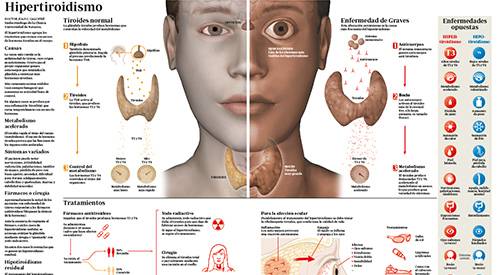Graves' Disease Basedow
"Graves-Basedow disease, like other thyroid diseases, is more common among women".
DR. JUAN CARLOS GALOFRÉ
SPECIALIST. THYROID DISEASE AREA

Graves-Basedow disease is a type of hyperthyroidism due to diffuse goiter.
It is related to the presence of thyroid-stimulating antibodies. It is more common in young people and can lead to the appearance of bulging eyes (exophthalmos) and swelling of the front of the legs (myxedema).
In the Clinic we have an Area of Thyroid Pathology formed by a multidisciplinary team of specialists who work together to offer patients with thyroid problems an accurate diagnosis, indicate the most appropriate treatment in their case and carry out a continuous follow-up to achieve the desired objectives.

What are the symptoms of Graves Basedow disease?
The most common symptoms are:
- Nervousness.
- Insomnia.
- Palpitations.
- Sweating.
- Trembling of hands.
- Bulging eyes.

Learn how hyperthyroidism is diagnosed and treated (available in spanish)
Do you have any of these symptoms?
You may have Graves Basedow disease
What are the causes of Graves Basedow?
In Graves-Basedow disease, the cause is related to the presence of thyroid-stimulating antibodies which, in addition to stimulating the thyroid to produce large amounts of thyroid hormones, is more common in young people and can lead to the appearance of bulging eyes (exophthalmos) and swelling of the legs (myxedema).
What is the prognosis of Graves Basedow disease?
Cases of Graves-Basedow disease can have an oscillating course with temporary remissions if left untreated.
However, any type of untreated hyperthyroidism can lead to an acute situation called a thyrotoxic crisis characterized by dehydration, severe cardiac tachycardia or arrhythmia, heart failure, obnubilation and impaired consciousness.
How is Graves Basedow disease diagnosed?

The appearance of the classic symptoms together with the appearance of goiter creates the diagnostic suspicion that is confirmed with the determination of thyroid hormones (T4 and T3) in blood that must be elevated. In rare cases only the T3 level is increased.
The concentration of TSH is very diminished, even below the detection limit. When there is suspicion of Graves/Basedow disease, positive antibodies (antithyroglobulin, antimicrosomal, TSI) are observed.
A thyroid scan can help to clarify the type and function of goiter and thus to better target the type of hyperthyroidism.
Sometimes it is necessary to make a thyroid ultrasound to assess the possible nodularity.
How is Graves Basedow treated?
Once diagnosed, treatment with oral antithyroids (carbimazole, methimazole, propylthiouracil), which inhibit the formation of thyroid hormones and will achieve an improvement in symptoms within 7-15 days, should be instituted.
During treatment, check-ups are needed every 3-4 months to monitor possible side effects. After that period, about 40% of cases go into permanent remission, while the rest relapse.
If the goiter is large, produces compressive symptoms or is accompanied by ocular alterations typical of Graves-Basedow disease, surgical treatment is indicated.
If the goiter is small in size or there is a high surgical risk, a dose of radioactive iodine can be administered orally, which will take effect in 1-2 months.
What clinical trials do we have on Graves Basedow Disease?
Where do we treat it?
IN NAVARRE AND MADRID
The Thyroid Pathology Area
of the Clínica Universidad de Navarra
The Thyroid Pathology Area is made up of a multidisciplinary team of specialists who work together to offer patients with thyroid problems an accurate diagnosis.
After the diagnosis, the patient is indicated the most appropriate treatment for his or her case and a continuous follow-up is carried out to achieve the desired objectives.
The Clinic is a pioneer in the implementation of medical techniques in Spain and worldwide, and is an international reference in highly specialized procedures.
What diseases do we treat?

Why at the Clinica?
- Prestigious professionals who are a national reference.
- In 24-48 hours we make the diagnosis and we can start the most appropriate treatment for each patient.















